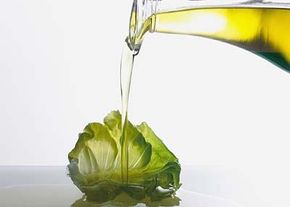How Olive Oil Is Made
The craft of turning olives into oil has been honed in the Mediterranean region over thousands of years, and techniques have been passed down from generation to generation. The process is truly a regional art. The method used in Greece is different from the one used in Spain, and each individual grower might have a unique way of tending the trees and producing the tasty liquid gold.
Mediterranean olive trees must mature for several years before they produce olives. Careful pruning optimizes the number of olives a single tree will bear. A meticulous hand is necessary because it takes at least ten pounds of olives to produce one liter (about four cups) of olive oil.
Advertisement
Hundreds of olive varieties exist, but only several dozen are grown commercially around the world. Some varieties are bursting with health-promoting polyphenols, while others contain few. The type of olive used to make any particular bottle of oil is rarely listed on the label. However, for those labels that do have the information, the following table, which shows which olives are richest in beneficial polyphenols, will be helpful.
The time at which olives are harvested also plays a major role in flavor and polyphenol content. The peak time is a short period right as the olives ripen. Olives are at their prime for only about two or three weeks. Healthy compounds then rapidly diminish over the next two to five weeks.
Picking Particulars
It takes quite a bit of work to coax oil out of olives. Traditionally, trees were shaken or beaten with sticks to make the olives drop to the ground. Such tough treatment is not good for olives, however. Tumbling out of a tree and plopping onto the ground causes bruising.
Soft fruits, such as peaches and plums, wouldn't take kindly to this type of treatment; they would bruise, too, and we would never think of harvesting them this way. Olives are also soft fruits that should be treated delicately because once they bruise, the beneficial oils within start to degrade.
Some olive oil labels declare that their bottles' contents are made from handpicked olives. This typically denotes a better-quality oil. Some growers separate their olives into "ground" olives (those collected from the ground) and "tree" olives (those picked from the tree) and use them for different grades of oil. Many large-scale growers use a tree-shaking device and set up nets beneath the trees that catch the olives before they hit the ground.
Growers must be careful when transporting olives from the trees to the processing plant. Olives are best carried in shallow containers so they don't pile up too deeply and crush one another. Any damage to the olives can trigger oxidation and fermentation, which create an "off" flavor. Olives should be processed soon after harvest because storing them also diminishes their quality.
Press Time
After olives are picked, any leaves, twigs, and stems are removed, and the olives are washed. Then it's time for pressing. Back in the old days, processors used stone or granite wheels to crush the olives.
Today, stainless steel rollers crush the olives and pits and grind them into paste. The paste then undergoes malaxation, a process in which water is slowly stirred into the paste. Malaxation allows the tiny oil molecules to clump together and concentrate.
The mixture is stirred for 20 to 40 minutes. Longer mixing times increase oil production and give the oil a chance to pick up additional flavors from the olive paste. However, the mixing also exposes the oil to air, producing free radicals that poorly affect its quality.
Modern systems use closed mixing chambers filled with a harmless gas to prevent oxidation. This method increases yield and flavor and preserves quality. The mixture may be heated to about 82 degrees Fahrenheit, which further increases yield but does allow some oxidation. This temperature is low enough to be considered "cold pressed."
Next, the paste is put on mats and further pressed or sent through a centrifuge (a compartment that is rotated on a central axis at extreme speed to separate materials). When the centrifuge spins, the olive paste remnants are pushed to the sides of the compartment cylinder while water and oil are extracted from the center of the centrifuge. The oil and water are later separated.
The solid material that remains after the extraction of the oil is called pomace, and it contains residual oil. Some manufacturers will use steam, hexane, or other solvents to squeeze more oil out of the pomace. This low-quality oil must be labeled as pomace oil.
Oil may then be refined, bleached, and/or deodorized. Refining reduces acidity and any bitter taste. Bleaching removes chlorophyll and carotenoids (naturally occurring pigments that give plants their colors) and possibly pesticides, resulting in a light-colored oil with fewer nutrients. Deodorizing removes the fragrant aroma of the olive oil.
In the manufacturing plant, oil is stored in stainless steel containers at about 65 degrees Fahrenheit to prevent breakdown before it is bottled and shipped.
Lots of different types of olive oil come out of the presses. On the next page you'll learn what all the label terms mean and what's inside each of the bottles.
To learn more about the topics covered in this article, check out the following links:
- To learn about how olive oil can improve your health, read The Health Benefits of Olive Oil.
- If you wanted to know how to grow and use garlic, try How to Plant and Store Garlic.
- Natural Weight-Loss Food: Olive Oil, can tell you more about how olive oil can help you lose weight.
